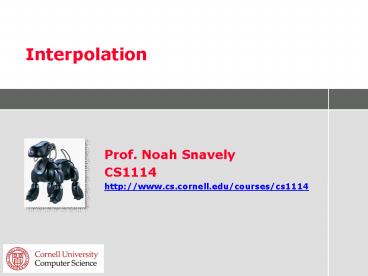Interpolation PowerPoint PPT Presentation
Title: Interpolation
1
Interpolation
Prof. Noah Snavely CS1114 http//www.cs.cornell.ed
u/courses/cs1114
2
Administrivia
- Assignment 3 due tomorrow by 5pm
- Please sign up for a demo slot
- Assignment 4 will be posted tomorrow evening
- Quiz 3 next Thursday
3
Today back to images
- This photo is too small
- Might need this for forensics
- http//www.youtube.com/watch?v3uoM5kfZIQ0
4
Zooming
- First consider a black and white image
- (one intensity value per pixel)
- We want to blow it up to poster size (say, zoom
in by a factor of 16) - First try repeat each row 16 times, then repeat
each column 16 times
5
Zooming First attempt
6
Interpolation
- That didnt work so well
- We need a better way to find the in between
values - Lets consider one horizontal slice through the
image (one scanline)
7
Interpolation
- Problem statement
- We are given the values of a function f at a few
locations, e.g., f(1), f(2), f(3), - Want to find the rest of the values
- What is f(1.5)?
- This is called interpolation
- We need some kind of model that predicts how the
function behaves
8
Interpolation
- Example
- f(1) 1, f(2) 10, f(3) 5 , f(4) 16,
f(5) 20
9
Interpolation
- How can we find f(1.5)?
- One approach take the average of f(1) and f(2)
f (1.5) 5.5
10
Linear interpolation (lerp)
- Fit a line between each pair of data points
11
Linear interpolation
- What is f(1.8)?
- Answer 0.2 f(1) 0.8 f(2)
f (1.8) 0.2 (1) 0.8 (10) 8.2
12
Linear interpolation
- To compute f(x), find the two points xleft and
xright that x lies between
f (x) (xright - x) / (xleft xright) f
(xleft) (x - xleft) / (xleft
xright) f (xright)
f (xleft)
f (xright)
x
xleft
xright
13
Nearest neighbor interpolation
- The first technique we tried
- We use the value of the data point we are closest
to - This is a fast way to get a bad answer
14
Bilinear interpolation
- What about in 2D?
- Interpolate in x, then in y
- Example
- We know the red values
- Linear interpolation in x between red values
gives us the blue values - Linear interpolation in y between the blue values
gives us the answer
http//en.wikipedia.org/wiki/Bilinear_interpolatio
n
15
Bilinear interpolation
http//en.wikipedia.org/wiki/Bilinear_interpolatio
n
16
Nearest neighbor interpolation
17
Bilinear interpolation
18
Beyond linear interpolation
- Fits a more complicated model to the pixels in a
neighborhood - E.g., a cubic function
http//en.wikipedia.org/wiki/Bicubic_interpolation
19
Bilinear interpolation
20
Bicubic interpolation
Smoother, but were still not resolving more
detail
21
Even better interpolation
- Detect curves in the image, represents them
analytically
22
Even better interpolation
nearest-neighbor interpolation
hq4x filter
SNES resolution 256x224 Typical PC resolution
1920x1200
As seen in ZSNES
23
Polynomial interpolation
- Given n points to fit, we can find a polynomial
p(x) of degree n 1 that passes through every
point exactly - p(x) -2.208 x4 27.08x3 - 114.30 x2
195.42x - 104
24
Polynomial interpolation
- For large n, this doesnt work so well
25
Other applications of interpolation
- Computer animation (keyframing)
26
Gray2Color
http//www.cs.huji.ac.il/yweiss/Colorization/ (Ma
tlab code available)
27
Limits of interpolation
- Can you prove that it is impossible to
interpolate correctly? - Suppose I claim to have a correct way to produce
an image with 4x as many pixels - Correct, in this context, means that it gives
what a better camera would have captured - Can you prove this cannot work?
- Related to impossibility of compression
28
Example algorithm that cant exist
- Consider a compression algorithm, like zip
- Take a file F, produce a smaller version F
- Given F, we can uncompress to recover F
- This is lossless compression, because we can
invert it - MP3, JPEG, MPEG, etc. are not lossless
- Claim there is no such algorithm that always
produces a smaller file F for every input file F
29
Proof of claim (by contradiction)
- Pick a file F, produce F by compression
- F is smaller than F, by assumption
- Now run compression on F
- Get an even smaller file, F
- At the end, youve got a file with only a single
byte (a number from 0 to 255) - Yet by repeatedly uncompressing this you can
eventually get F - However, there are more than 256 different files
F that you could start with!
30
Conclusions
- Some files will get larger if you compress them
(usually files with random data) - We cant (always) correctly recover missing data
using interpolation - A low-res image can represent multiple high-res
images
31
Extrapolation
- Suppose you only know the values f(1), f(2),
f(3), f(4) of a function - What is f(5)?
- This problem is called extrapolation
- Much harder than interpolation what is outside
the image? - For the particular case of temporal data,
extrapolation is called prediction (what will the
value of MSFT stock be tomorrow?) - If you have a good model, this can work well
32
Image extrapolation
http//graphics.cs.cmu.edu/projects/scene-completi
on/ Computed using a database of millions of
photos
33
Questions?

